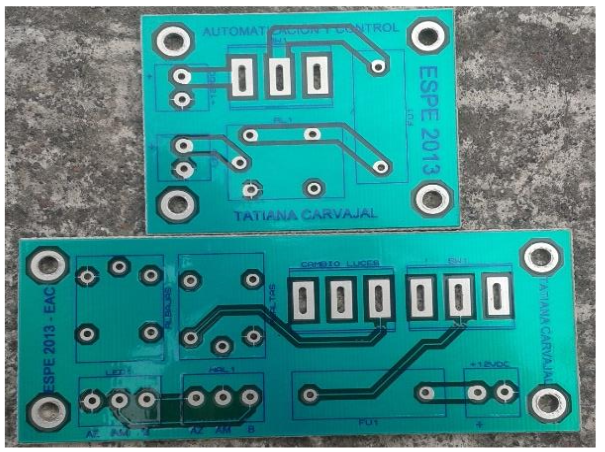Control system using LabVIEW to analyze automotive light pollution
Main Article Content
Abstract
A control system has been developed using LabView to analyze automotive light pollution in the environment. Some phenomena analyzed are irradiance, emission spectra, and optical power. The lights analyzed were halogen and LED. The study was carried out using an electronic circuit similar to cars' light control. The results obtained through the LabView platform indicated that the German halogen bulbs, the best sellers in Ecuador, do not have harmful irradiation as with LEDs; even so, they have exaggeratedly high powers, causing glare at night. For their part, LEDs have been shown to have low power but high light intensity at the wavelengths of 430nm or 450nm, in white and blue LEDs, respectively. These wavelengths cause various damages to the ecological system and health when the subject is exposed for long periods.
Downloads
Article Details

This work is licensed under a Creative Commons Attribution 4.0 International License.
Authors who publish in this journal agree to the following terms: Authors retain the copyright and guarantee the journal the right to be the first publication of the work, as well as, licensed under a Creative Commons Attribution License that allows others share the work with an acknowledgment of the authorship of the work and the initial publication in this journal. Authors may separately establish additional agreements for the non-exclusive distribution of the version of the work published in the journal (for example, placing it in an institutional repository or publishing it in a book), with acknowledgment of its initial publication in this journal. Authors are allowed and encouraged to disseminate their work electronically (for example, in institutional repositories or on their own website) before and during the submission process, as it may lead to productive exchanges as well as further citation earliest and oldest of published works.
How to Cite
References
[2] López, L. P., & Pérez, S. M. (2008). Neuroanatomía. Madrid: Editorial Médica Panamericana.
[3] Maestre, D. G. (2007). Ergonomía y psicosociología. Madrid: FC Editorial.
[4] Chepesiuk, R. (Septiembre- Octubre de 2010). Extrañando la oscuridad: los efectos de la contaminación lumínica sobre la salud. Cuernavaca, Morelos, México.
[5] Rich, C., & Longcore, T. (2005). Ecological Consequences of Artificial Night Lighting. Washington, DC: Island Press.
[6] Wu, J., Seregard, S., & Algvere, P. V. (Septiembre- Octubre de 2006). Survey of Ophthalmology. Photochemical Damage of the Retina. Estocolmo, Suecia: Elsevier.
[7] CHAMORRO, E., BONNIN, C., LOBATO, L. L., NAVARRO, J. J., RAMÍREZ, G., NAVARRO, C., & SÁNCHEZ., C. (2012). Riesgos personlaes producidos por LEDs utilizados en dispositivos de uso cotidiano. Seguridad y Medio Ambiente, 36- 41.
[8] Falchi, F., Cinzano, P., Elvidge, C., Keith, D., & Haim, A. (13 de Julio de 2011). Limiting the impact of light pollution on human health, environment and stellar visibility. Journal of Environmental Management. Estados Unidos: Elsevier.
[9] Peña, J. M., Lozano, C., & Díaz, F. (2000). Grupo de trabajo 20: Contaminación lumínica. Madrid.
[10] Dorremochea, C. H. (2010). Hágase la luz, mitos y realidad en la protección del cielo nocturno. Revista Astrónoma Nº 129, 34-40.
[11] Skoog, D. A., Crouch, S. R., & Holler, F. J. (2007). Principles of Instrumental Analysis. New York: Brooks/Cole
[12] Croft, T., Carr, C. L., & Watt, J. H. (1974). American electrician's handbook. New York: Mc Graw- Hill Book Company.
[13] Gil, F. J. (2011). Manual del Permiso B. Madrid: Arisoft Editorial SA.
[14] Lázaro, A. M. (2000). LabVIEW 6i (Programación gráfica para el control de instrumentación). Madrid: Editorial Paraninfo.
[15] Sánchez, J. G. (2009). Circuitos electrotécnicos básicos: sistemas de carga y arranque : electromecánica de vehículos. Madrid: Editorial Paraninfo.
[16] Coherent, Inc. (25 de 11 de 2013). Coherent Incorporated. Obtenido de Coherent Web Site: http://www.coherent.com/Applications/index.cfm?fuseaction=Forms.page&PageID=116
[17] Coherent, Inc. (1 de December de 2004). Coherent Incorporated. Obtenido de Coherent Web Site: http://www.coherent.com
[18] Martín, J., Soriano, J. S., & Escobar, T. A. (23 de abril de 2007). Infoleds. Obtenido de http://infoleds.wordpress.com

